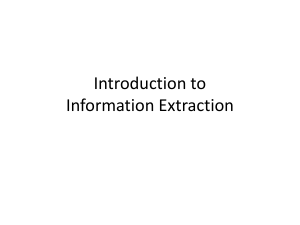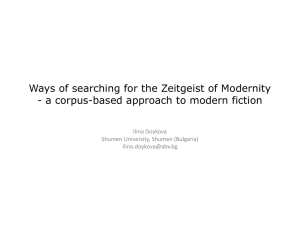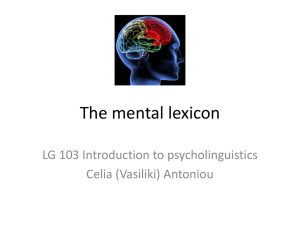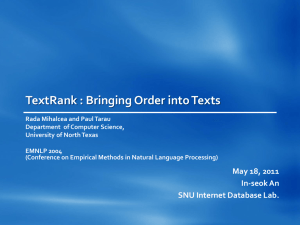Power Point
advertisement
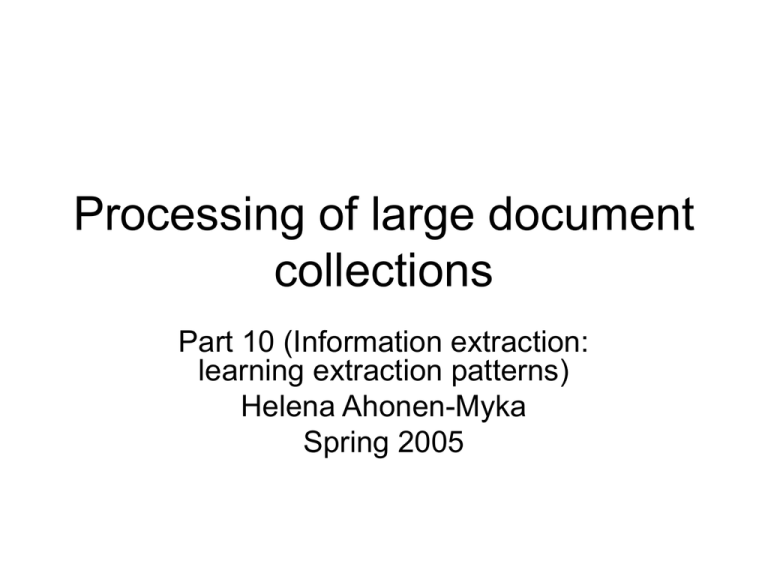
Processing of large document
collections
Part 10 (Information extraction:
learning extraction patterns)
Helena Ahonen-Myka
Spring 2005
Learning of extraction patterns
• IE systems depend on a domain-specific
knowledge
– acquiring and formulating the knowledge may require
many person-hours of highly skilled people (usually
both domain and the IE system expertize is needed)
– the systems cannot be easily scaled up or ported to
new domains
– automating the domain knowledge acquisition is
needed
2
Learning of extraction patterns
• AutoSlog
• AutoSlog-TS
• Multi-level bootstrapping
3
AutoSlog
• Ellen Riloff, University of Massachusetts
– Automatically constructing a dictionary for information
extraction tasks, 1993
• given a training corpus, AutoSlog proposes a set
of patterns that are capable of extracting the
desired information from the training texts
• if the training corpus is representative of the
target texts, the patterns should work also with
new texts
4
Domain-specific knowledge
• the UMASS/MUC4 system used 2 dictionaries
– a part-of-speech lexicon: 5436 lexical definitions,
including semantic features for domain-specific words
– a dictionary of 389 extraction patterns (= concept
node definitions)
• for MUC4, the concept node dictionary was
manually constructed by 2 graduate students:
1500 person-hours
5
AutoSlog
• two central observations:
– the most important facts about a news event
are typically reported during the initial event
description
• the first reference to a targeted piece of
information (e.g. a victim) is most likely where the
relationship between that information and the
event is made explicit
6
AutoSlog
– the immediate linguistic context surrounding
the targeted information usually contains the
words or phrases that describe its role in the
event
• e.g. ”A U.S. diplomat was kidnapped by FMLN
guerillas”
• the word ’kidnapped’ is the key word that relates
the victim (A U.S. diplomat) and the perpetrator
(FMLN guerillas) to the kidnapping event
• ’kidnapped’ is the triggering word
7
Algorithm
• given a set of training texts and their associated answer
keys
– AutoSlog proposes a set of patterns that are capable of
extracting the information in the answer keys from the texts
• given a string from an answer key template (= targeted
string)
– AutoSlog finds the first sentence in the text that contains the
string
– the sentence is given to a syntactic analysis component which
generates an analysis of the sentence
– using the analysis, AutoSlog identifies the first clause in the
sentence that contains the string
8
Algorithm
– a set of heuristic rules are applied to the clause to
suggest a good triggering word for a extraction
pattern
– if none of the heuristic rules is satisfied then AutoSlog
searches for the next sentence in the text and
process is repeated
9
Heuristic rules
• each heuristic rule looks for a specific linguistic pattern in
the clause surrounding the targeted string
• if a heuristic identifies its pattern in the clause then it
generates
– a triggering word
– a set of enabling conditions
10
Conceptual anchor point
heuristics
• suppose
– the clause ”the diplomat was kidnapped”
– the targeted string ”the diplomat”
• the targeted string appears as the subject and is
followed by a passive verb ’kidnapped’
• a heuristic that recognizes the pattern
<subject> passive-verb is satisfied
– returns the word ’kidnapped’ as the triggering word,
and
– as enabling condition: a passive construction
11
Linguistic patterns
• <subj> passive-verb
• <subj> active-verb
• <subj> verb infinitive
• <victim> was murdered
• <perpetrator> bombed
• <perpetrator> attempted to
kill
•
•
•
•
•
•
•
•
<subj> aux noun
passive-verb <dobj>
active-verb <dobj>
infinitive <dobj>
<victim> was victim
killed <victim>
bombed <target>
to kill <victim>
12
Linguistic patterns
• verb infinitive <dobj>
• threatened to attack
<target>
•
•
•
•
•
•
•
•
•
•
gerund <dobj>
noun aux <dobj>
noun prep <np>
active-verb prep <np>
passive-verb prep <np>
killing <victim>
fatality was <victim>
bomb against <target>
killed with <instrument>
was aimed at <target>
13
Building extraction patterns
• a slot to extract the information
– the name of the slot comes from the answer
key template
• ”the diplomat” is Victim -> slot: Victim
– the syntactic constituent comes from the
linguistic pattern, e.g. the filler is the subject
of the clause
• ”the diplomat” is subject -> slot: Victim *Subject*
14
Building extraction patterns
• hard and soft constraints for the slot
– e.g. constraints to specify a legitimate victim
• a type
– e.g. the type of the event (bombing, kidnapping) from
the answer key template
15
Example
…, public buildings were bombed and a car-bomb was…
Filler of the slot ’Phys_Target’ in the answer key template:”public
buildings”
Pattern (concept node definition):
Name: target-subject-passive-verb-bombed
Trigger: bombed
Slot: Phys_Target *Subject*
Slot-constraints: class phys-target *Subject*
Constant-slots: type bombing
Enabled-by: passive
16
A bad definition
”they took 2-year-old gilberto molasco, son of patricio rodriguez, ..”
Pattern (concept node definition):
Name: victim-active-verb-dobj-took
Trigger: took
Slot: victim *DirectObject*
Slot-constraints: class victim *DirectObject*
Constant-slots: type kidnapping
Enabled-by: active
17
A bad pattern
• a pattern is triggered by the word ”took” as
an active verb
• this pattern is appropriate for this
sentence, but in general we don’t want to
generate a kidnapping node every time we
see the word ”took”
18
Bad definitions
• AutoSlog generates bad definitions for
many reasons
– a sentence contains the targeted string but
does not describe the event
– a heuristic proposes a wrong triggering word
– syntactic analysis works incorrectly
• solution: human-in-the-loop
19
Empirical results
• training data: 1500 texts (MUC-4) and
their associated answer keys
– 6 slots were chosen
– 1258 answer keys contained 4780 string
fillers
• result:
– 1237 extraction patterns
20
Empirical results
• human-in-the-loop:
– 450 definitions were kept
– time spent: 5 hours (compare: 1500 hours for a handcrafted set of patterns)
• the resulting set of extraction patterns was
compared with a hand-crafted set within the
UMass/MUC-4 system
– precision, recall, F-measure almost the same
21
AutoSlog-TS
• Riloff (University of Utah): Automatically
generating extraction patterns from
untagged text, 1996
22
Extracting patterns from
untagged text
• AutoSlog needs manually tagged or
annotated information to be able to extract
patterns
• manual annotation is expensive,
particularly for domain-specific
applications like IE
– may also need skilled people
– ~8 hours to annotate 160 texts (AutoSlog)
23
AutoSlog-TS
• needs only a preclassified corpus of relevant and
irrelevant texts
– much easier to generate
– relevant texts are available online for many applications
• generates an extraction pattern for every noun
phrase in the training corpus
• the patterns are evaluated by processing the
corpus and generating relevance statistics for
each pattern
24
Process
• Stage 1:
– the sentence analyzer produces a syntactic analysis
for each sentence and identifies the noun phrases
– for each noun phrase, the heuristic (AutoSlog) rules
generate a pattern (a concept node) to extract the
noun phrase
• if more than one rule matches the context, multiple extraction
patterns are generated
• <subj> bombed, <subj> bombed embassy
25
Process
• Stage 2:
– the training corpus is processed a second
time using the new extraction patterns
– the sentence analyzer activates all patterns
that are applicable in each sentence
– relevance statistics are computed for each
pattern
– the patterns are ranked in order of importance
to the domain
26
Relevance statistics
• relevance rate: Ri = Fi / Ni
– Fi : the number of instances of pattern i that were
activated in the relevant texts
– Ni: the total number of instances of pattern i in the
training corpus
• domain-specific expressions appear
substantially more often in relevant texts than in
irrelevant texts
27
Ranking of patterns
• the extraction patterns are ranked
according to the formula:
– scorei = Ri * log (Fi)
– or zero, if Ri < 0.5
• in this case, the pattern is negatively correlated
with the domain (assuming the corpus is 50%
relevant)
• the formula promotes patterns that are
– highly relevant or highly frequent
28
The top 25 extraction patterns
•
•
•
•
•
•
•
•
<subj> exploded
murder of <np>
assassination of <np>
<subj> was killed
<subj> was kidnapped
attack on <np>
<subj> was injured
exploded in <np>
29
The top 25 extraction patterns,
continues
•
•
•
•
•
•
•
•
death of <np>
<subj> took place
caused <dobj>
claimed <dobj>
<subj> was wounded
<subj> occurred
<subj> was located
took_place on <np>
30
The top 25 extraction patterns,
continues
•
•
•
•
•
•
•
•
•
responsibility for <np>
occurred on <np>
was wounded in <np>
destroyed <dobj>
<subj> was murdered
one of <np>
<subj> kidnapped
exploded on <np>
<subj> died
31
Human-in-the-loop
• the ranked extraction patterns were
presented to a user for manual review
• the user had to
– decide whether a pattern should be accepted
or rejected
– label the accepted patterns
• murder of <np> -> <np> means the victim
32
AutoSlog-TS: conclusion
• empirical results comparable to AutoSlog
– recall slightly worse, precision better
• the user needs to
– provide sample texts (relevant and irrelevant)
– spend some time filtering and labeling the
resulting extraction patterns
33
Multi-level bootstrapping
• Riloff (Utah), Jones(CMU): Learning
Dictionaries for Information Extraction by
Multi-level Bootstrapping, 1999
34
Multi-level bootstrapping
• an algorithm that generates
simultaneously
– a semantic lexicon
– extraction patterns
• input: unannotated training texts and a few
seed words for each category of interest
(e.g. location)
35
Mutual bootstrapping
• observation: extraction patterns can
generate new examples of a semantic
category, which in turn can be used to
identify new extraction patterns
36
Mutual bootstrapping
• process begins with a text corpus and a
few predefined seed words for a semantic
category
– text corpus: e.g. terrorist events texts, web
pages
– semantic category : (e.g.) location, weapon,
company
37
Mutual bootstrapping
• AutoSlog is used in an exhaustive fashion
to generate extraction patterns for every
noun phrase in the corpus
• the extraction patterns are applied to the
corpus and the extractions are recorded
38
Mutual bootstrapping
• input for the next stage:
– a set of extraction patterns, and for each
pattern, the NPs it can extract from the
training corpus
– this set can be reduced by pruning the
patterns that extract one NP only
• general (enough) linguistic expressions are
preferred
39
Mutual bootstrapping
• using the data, the extraction pattern is
identified that is most useful for extracting
known category members
– known category members in the beginning =
the seed words
– e.g. in the example, 10 seed words were used
for the location category (in terrorist texts):
bolivia, city, colombia, district, guatemala,
honduras, neighborhood, nicaragua, region,
town
40
Mutual bootstrapping
• the best extraction pattern found is then
used to propose new NPs that belong to
the category (= should be added to the
semantic lexicon)
• in the following algorithm:
– SemLex = semantic lexicon for the category
– Cat_EPlist = the extraction patterns chosen
for the category so far
41
Algorithm
• Generate all candidate extraction patterns
from the training corpus using AutoSlog
• Apply the candidate extraction patterns to
the training corpus and save the patterns
with their extractions to EPdata
• SemLex = {seed_words}
• Cat_EPlist = {}
42
Algorithm, continues
• Mutual Bootstrapping Loop
– 1. Score all extraction patterns in EPdata
– 2. best_EP = the highest scoring extraction
pattern not already in Cat_EPlist
– 3. Add best_EP to Cat_EPlist
– 4. Add best_EP’s extractions to SemLex
– 5. Go to step 1
43
Mutual bootstrapping
• at each iteration, the algorithm saves the
best extraction pattern for the category to
Cat_EPlist
• all of the extractions of this pattern are
assumed to be category members and are
added to the semantic lexicon
44
Mutual bootstrapping
• in the next iteration, the best pattern that is
not already in Cat_EPlist is identified
– based on both the original seed words + the
new words that have been added to the
lexicon
• the process repeats until some end
condition is reached
45
Scoring
• based on how many different lexicon
entries a pattern extracts
• the metric rewards generality
– a pattern that extracts a variety of category
members will be scored higher than a pattern
that extracts only one or two different category
members, no matter how often
46
Scoring
• head phrase matching:
– X matches Y if X is the rightmost substring of Y
– ”New Zealand” matches ”eastern New Zealand”
and ”the modern day New Zealand”
– … but not ”the New Zealand coast” or ”Zealand”
– important for generality
• each NP was stripped of leading articles,
common modifiers (”his”, ”other”,…) and
numbers before being saved to the lexicon
47
Scoring
• the same metric was used as in AutoSlog-TS
– score(patterni) = Ri * log(Fi)
• Fi: the number of unique lexicon entries
among the extractions produced by pattern i
• Ni: the total number of unique NPs that pattern
i extracted
• Ri = Fi / Ni
48
Example
• 10 seed words were used for the location
category (terrorist texts):
– bolivia, city, colombia, district, guatemala,
honduras, neighborhood, nicaragua, region,
town
• the first five iterations...
49
Example
Best pattern
”headquartered in <x> (F=3, N=4)
Known locations nicaragua
New locations
san miguel, chapare region, san miguel city
Best pattern
”gripped <x>” (F=2, N=2)
Known locations colombia, guatemala
New locations
none
50
Example
Best pattern
”downed in <x>” (F=3, N=6)
Known locations nicaragua, san miguel*, city
New locations
area, usulutan region, soyapango
Best pattern
”to occupy <x>” (F=4, N=6)
Known locations nicaragua, town
New locations
small country, this northern area,
san sebastian neighborhood, private property
51
Example
Best pattern
”shot in <x>” (F=5, N=12)
Known locations city, soyapango*
New locations
jauja, central square, head, clash, back,
central mountain region, air,
villa el_salvador district,
northwestern guatemala, left side
52
Strengths and weaknesses
• the extraction patterns have identified
several new location phrases
– jauja, san miguel, soyapango, this northern area
• but several non-location phrases have also
been generated
– private property, head, clash, back, air, left side
– most mistakes due to ”shot in <x>”
• many of these patterns occur infrequently in
53
the corpus
Multi-level bootstrapping
• the mutual bootstrapping algorithm works
well but its performance can deteriorate
rapidly when non-category words enter the
semantic lexicon
• once an extraction pattern is chosen for
the dictionary, all of its extractions are
immediately added to the lexicon
– few bad entries can quickly infect the
dictionary
54
Multi-level bootstrapping
• for example, if a pattern extracts dates as
well as locations, then the dates are added
to the lexicon and subsequent patterns are
rewarded for extracting these dates
• to make the algorithm more robust, a
second level of bootstrapping is used
55
Multi-level bootstrapping
• the outer bootstrapping mechanism
(”meta-bootstrapping”)
– compiles the results from the inner (mutual)
bootstrapping process
– identifies the five most reliable lexicon entries
– these five NPs are retained for the permanent
semantic lexicon
– the entire mutual bootstrapping process is
then restarted from scratch (with new lexicon)
56
Multi-level bootstrapping
• number of iterations: 50 (for instance)
• output:
– extraction patterns generated by the last
iteration
• extraction patterns from the previous iterations are
thrown away
– permanent semantic lexicon
57
Scoring for reliability
• to determine which NPs are most reliable,
each NP is scored based on the number of
different category patterns that extracted it
• intuition: a NP extracted by e.g. three
different category patterns is more likely to
belong to the category than a NP
extracted by only one pattern
58
Multi-level bootstrapping
• the main advantage of meta-bootstrapping
comes from re-evaluating the extraction
patterns after each mutual bootstrapping
process
• in practice, the ordering of patterns
changes: more general patterns float to
the top as the semantic lexicon grows
59
Multi-level bootstrapping:
conclusion
• both a semantic lexicon and a dictionary of
extraction patterns are acquired
simultaneously
• resources needed:
– corpus of (unannotated) training texts
– a small set of words for a category
60
